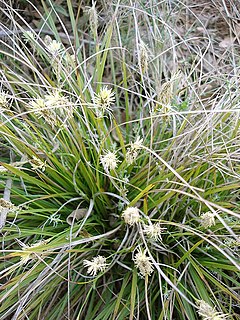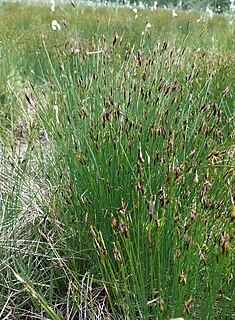
Hymenolepis diminuta, also known as rat tapeworm, is a species of Hymenolepis tapeworm that causes hymenolepiasis. It has slightly bigger eggs and proglottids than H. nana and infects mammals using insects as intermediate hosts. The adult structure is 20 to 60 cm long and the mature proglottid is similar to that of H. nana, except it is larger.
There are over 190 vascular plant species on the Norwegian Arctic archipelago of Svalbard. This figure does not include algae, mosses, and lichens, which are non-vascular plants. For an island so far north, this number of species constitutes an astonishing variety of plant life. Because of the harsh climate and the short growing season, all the plants are slow growing. They seldom grow higher than 10 cm (4 in)

Carex is a vast genus of more than 2,000 species of grass-like plants in the family Cyperaceae, commonly known as sedges. Other members of the family Cyperaceae are also called sedges, however those of genus Carex may be called true sedges, and it is the most species-rich genus in the family. The study of Carex is known as caricology.

Schoenus is a predominately austral genus of sedges, commonly known as bogrushes, or veldrushes in South Africa. Species of this genus occur mainly in South Africa, Australia and Southeast Asia. Others are found in scattered locations worldwide, from Europe to Asia, North Africa and the Americas. Three species occur in the peatlands of southern South America, including S. antarcticus which is found in Tierra del Fuego, where it forms a component of hyperhumid Magellanic moorland.

Grevillea diminuta is a species of flowering plant in the family Proteaceae and is endemic to eastern Australia. It is a small, spreading shrub with elliptic to egg-shaped leaves and cylindrical to dome-shaped groups of reddish-brown flowers.
Johann Otto Boeckeler was a German apothecary-botanist of Oldenburg. He specialized in the plant family Cyperaceae (sedges), of which, he was the binomial authority of many species.
Scabby Range Nature Reserve is a heritage-listed protected area at Sams River Fire Trail, Yaouk, New South Wales, Australia. It was established on 3 December 1982 and added to the former Australian Register of the National Estate on 30 June 1992. It was added to the Australian National Heritage List as part of the Australian Alps National Parks and Reserves on 7 November 2008.
Cyperus anderssonii, commonly known as Andersson's sedge, is a species of sedge that is endemic to the Galapagos Islands.

Cyperus entrerianus, commonly known as the woodrush flatsedge, is a species of sedge that is native to southern parts of North America, Central America, and parts of South America.
Carex steudneri is a tussock-forming species of perennial sedge in the family Cyperaceae. It is native to the eastern part of Africa from Ethiopia in the north to South Africa.

Carex cruenta is a tussock-forming species of perennial sedge in the family Cyperaceae. It is native to parts of Asia, from Pakistan in the west to south central parts of China in the east.

Carex donnell-smithii is a tussock-forming species of perennial sedge in the family Cyperaceae. It is native to parts of Mexico and Central America.

Carex gravida, also known as heavy-fruited sedge, heavy sedge or long-awned bracted sedge, is a tussock-forming species of perennial sedge in the family Cyperaceae. It is native to southern parts of Canada and parts of the United States.

Carex hendersonii, also known as Henderson's sedge or carex de Henderson, is a tussock-forming species of perennial sedge in the family Cyperaceae. It is native to western parts of North America.

Carex litorosa, commonly known as sea sedge, is a tussock-forming species of perennial sedge in the family Cyperaceae. It is native to New Zealand.
Carex burchelliana is a tussock-forming species of perennial sedge in the family Cyperaceae. It is native to parts of South Africa.
Carex catharinensis is a tussock-forming species of perennial sedge in the family Cyperaceae. It is native to parts of eastern parts of South America.
Carex ceylanica is a tussock-forming species of perennial sedge in the family Cyperaceae. It is native to parts of Sri Lanka.









